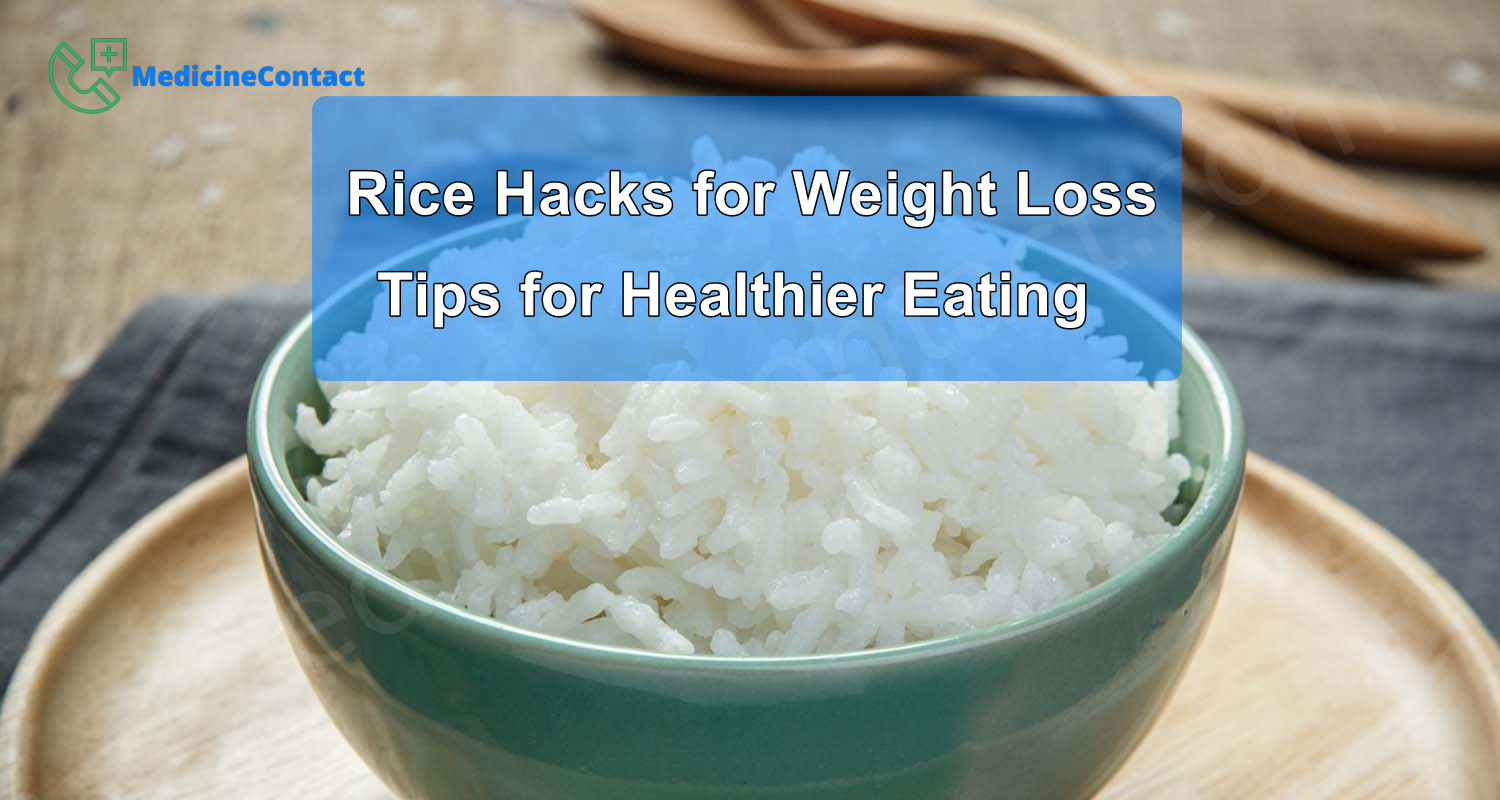
Introduction
Rice is a staple food enjoyed by people all over the world, but it often gets a bad reputation in weight loss discussions. However, what if there was a way to enjoy your favorite grain without compromising your health goals? In this article, we'll explore rice hacks for weight loss, providing you with effective tips to shed those extra pounds while still enjoying rice.
Many individuals are turning to these innovative techniques, widely known as rice hacks, to manage their calorie intake while still savoring rice. The popularity stems from the desire to balance enjoyment with nutritional benefits. By incorporating these methods, you can transform rice into a more weight-friendly option.
What You'll Gain
In this article, you'll discover:
- Practical Tips: Learn simple yet powerful methods to incorporate rice into your diet.
- Healthy Rice Options: Explore alternatives that offer better nutritional value.
- Weight Loss Tips: Understand how specific cooking techniques can aid in calorie management.
By the end of this read, you'll be equipped with actionable strategies to make rice a healthy part of your weight loss journey.
Understanding Rice Hacks for Weight Loss
Rice hacks for weight loss are innovative techniques designed to make rice consumption more compatible with a weight management plan. These hacks often involve modifying the way rice is cooked or consumed to either reduce its caloric impact or improve its nutritional profile.
Calorie Content and Glycemic Index
Understanding the calorie content and glycemic index (GI) of rice is crucial when considering it for a weight loss diet. The calorie content refers to the number of calories per serving, which directly impacts energy intake. The glycemic index measures how quickly foods raise blood sugar levels, with lower GI foods being more suitable for sustained energy and reduced cravings.
Making Informed Choices
To effectively incorporate these hacks for weight loss with rice, it's important to:
- Choose rice varieties that align with your dietary goals.
- Utilize cooking methods that enhance the nutritional benefits while reducing unwanted calories.
By making informed choices about rice consumption, individuals can enjoy this staple food without compromising their health objectives.
1. Coconut Oil Method: Enhancing Resistant Starch
The coconut oil rice method is an interesting way to potentially reduce the calorie content of rice. Here's how it works:
- Add a teaspoon of coconut oil to boiling water before cooking the rice.
- Cook the rice as usual.
- Refrigerate the cooked rice for about 12 hours.
How It Works
Research suggests that this process increases the resistant starch content in the rice. Resistant starch is a type of carbohydrate that doesn't get digested in the small intestine but ferments in the large intestine, acting more like fiber than starch. By increasing resistant starch, the body absorbs fewer calories from the rice.
Benefits of Resistant Starch
Higher levels of resistant starch offer several health benefits:
- Blood Sugar Regulation: Helps lower blood sugar spikes after meals.
- Calorie Reduction: Reduces the number of calories absorbed from the rice.
- Improved Gut Health: Acts as a prebiotic, promoting healthy gut bacteria.
This method not only makes rice a more weight-loss-friendly food but also allows you to enjoy it without significantly compromising your dietary goals.
Making Rice Healthier
In addition to the coconut oil method, there are other ways to make rice healthier and more gut-friendly. For instance, incorporating certain cooking techniques or adding specific ingredients can further enhance its nutritional profile. You can explore these methods in detail in this guide on making rice healthier and gut-friendly.
Moreover, understanding the truth about rice can provide valuable insights into its nutritional aspects and help you make informed dietary choices.
2. Parboiled Rice: A Nutritional Alternative
Parboiled rice stands out due to its unique processing method. Unlike regular white rice, which is milled directly from raw grains, parboiled rice undergoes a partial boiling process while still in its husk. This technique allows the grain to absorb nutrients from the outer layers before they are removed, resulting in a more nutrient-dense product.
Nutritional Advantages
- Iron and Calcium Content: Parboiled rice retains higher levels of essential minerals such as iron and calcium, making it a healthier choice compared to regular white rice.
- Vitamin Preservation: The steaming process helps lock in vitamins like B6 and niacin, which contribute to better overall health.
Benefits for Gut Health and Insulin Sensitivity
- Gut Health Improvement: The increased fiber content in parboiled rice supports digestive health by promoting regular bowel movements and feeding beneficial gut bacteria.
- Enhanced Insulin Sensitivity: Studies have shown that parboiled rice has a lower glycemic index than traditional white rice. This means it causes slower spikes in blood sugar levels, helping improve insulin sensitivity and potentially aiding weight management.
Understanding these benefits makes parboiled rice an excellent option within the framework of any rice hack for weight loss strategy. It's not only about calorie reduction but also ensuring each meal is nutritionally balanced and supports overall well-being.
3. Straining Starch: A Simple Cooking Technique
Straining starch is an effective method to reduce calorie intake with rice. This technique focuses on removing excess starch, which can contribute to the overall caloric density of your meal.
How to Strain Excess Starch During Cooking:
- Rinse the Rice: Before cooking, rinse the rice thoroughly under cold water until the water runs clear.
- Boil with Extra Water: Use a large pot and add extra water (about 6-10 times the amount of rice). Bring it to a boil.
- Cook the Rice: Add the rinsed rice to the boiling water and cook until tender (usually about 10-15 minutes).
- Drain: Once cooked, pour the rice into a fine-mesh strainer or colander to drain off the excess water and starch.
- Rinse Again: For further starch removal, rinse the cooked rice under hot running water for a few seconds.
Effects on Caloric Density and Texture
- Caloric Density: Straining starch reduces the glycemic index and caloric content of rice, making it a lighter option for weight-conscious individuals.
- Texture: The resulting texture is fluffier and less sticky compared to traditionally cooked rice, which some may find more palatable.
Comparison with Traditional Cooking Methods
Traditional methods often involve cooking rice with a precise amount of water that is fully absorbed during cooking. This results in higher starch content and potentially increased calorie intake. By using extra water and draining it off, this alternative method provides a healthier option without compromising taste.
Straining starch offers a simple yet effective way to enjoy rice while managing caloric intake, blending seamlessly into various dietary plans focused on weight loss.
4. Rice Water Consumption: A Hydrating Strategy
Rice water, the liquid leftover after cooking rice, has long been valued for its nutritional benefits and versatility. Incorporating rice water into your meals or as a drink can be an effective weight loss strategy due to its high-water content, which helps reduce overall caloric intake.
Benefits of High-Water Content
- Hydration: Drinking rice water can keep you hydrated while providing essential nutrients from the rice.
- Caloric Control: The high-water content can make you feel fuller, potentially reducing the amount of food you consume during meals.
- Nutrient-Rich: Rice water retains some of the vitamins and minerals from the rice grains, making it a nutrient-rich addition to your diet.
Creative Ways to Incorporate Rice Water
- Congee: This traditional porridge is made by simmering rice in water until it breaks down into a thick consistency. It's a comforting and filling dish that can be enhanced with vegetables, lean proteins, or spices.
- Smoothies: Use rice water as a base for smoothies instead of regular water or milk. It adds a subtle flavor and boosts nutrient content.
- Soups and Stews: Add rice water to soups and stews as a nutritious broth substitute, enhancing both flavor and nutritional value.
Rice water consumption offers a practical way to enjoy the benefits of nutrient-rich rice without consuming excess calories.
5. Exploring Other Healthy Rice Options
Introduction to Various Types of Healthy Rice Alternatives
Exploring different types of rice can be a game-changer for those focused on weight management. Here are some nutritious alternatives:
- Brown Rice: Retains the bran and germ, making it high in fiber, vitamins, and minerals.
- Black Rice: Rich in antioxidants, particularly anthocyanins, which support heart health.
- Red Rice: Packed with iron and other essential nutrients, contributing to overall well-being.
Benefits of Incorporating Exotic Grains into a Weight Loss Diet
These exotic rice varieties offer substantial benefits:
- Enhanced Nutritional Profile: Higher fiber content aids digestion and promotes satiety.
- Lower Glycemic Index: Helps maintain stable blood sugar levels.
- Rich in Antioxidants: Supports immune function and reduces inflammation.
How Cauliflower Rice Serves as a Low-Calorie Substitute
Cauliflower rice stands out as an excellent low-calorie alternative:
- Caloric Reduction: Significantly fewer calories compared to traditional rice.
- Gluten-Free Option: Suitable for those with gluten sensitivities.
- Versatility in Dishes: Easily incorporated into various recipes like stir-fries and salads.
By integrating these healthy rice options into your diet, you can enjoy a diverse range of flavors and textures while staying aligned with your weight loss goals.
Meal Planning with Rice Hacks
Creating balanced meal plans that incorporate the discussed rice hacks can be both enjoyable and beneficial for weight management. Here are some practical tips to help you integrate these methods into your daily meals:
Tips for Balanced Meal Plans
- Combine Protein with Rice: Pair your modified rice with lean proteins like chicken, fish, or legumes. This not only increases satiety but also balances macronutrient intake.
- Incorporate Vegetables: Add a variety of vegetables to your rice dishes. Vegetables like broccoli, bell peppers, and carrots enhance the nutritional profile and add fiber to keep you full longer.
- Portion Control: Use smaller serving sizes of rice while increasing the portions of vegetables and protein. This helps in managing calorie intake without compromising on taste.
Healthy Recipes Featuring Modified Cooking Techniques
Coconut Oil Rice with Grilled Chicken
Ingredients: 1 cup parboiled rice, 1 tsp coconut oil, grilled chicken breast, mixed vegetables.
Method: Cook the rice using the coconut oil method and refrigerate it. Serve with grilled chicken and steamed vegetables.
Strained Starch Rice Bowl
Ingredients: 1 cup white rice, plenty of water for boiling, tofu, stir-fried veggies (e.g., bell peppers, zucchini).
Method: Boil the rice with extra water and strain after cooking. Top with tofu and a mix of stir-fried veggies.
Rice Water Congee
Ingredients: Leftover rice water, shredded chicken or fish, green onions, ginger.
Method: Simmer the rice water with shredded chicken or fish until it becomes a thick porridge. Garnish with green onions and ginger.
Exploring these recipes can help you find healthy ways to enjoy rice while keeping your calorie goals in check. Experimenting with different ingredients and techniques ensures variety in your diet without sacrificing flavor or nutrition.
Conclusion
Adding these rice hacks to your diet and nutrition can help with weight management and encourage lifestyle changes. Each method has its own benefits, like increasing resistant starch, boosting gut health, or cutting down on calories.
Try out these techniques and see how they work for your weight loss journey. We’d love to hear about your experiences or any feedback you have in the comments section below.
You can also consult with an expert for a balanced diet for better health.
Remember, the key is to find balance and enjoy the foods you love in moderation.
FAQs (Frequently Asked Questions)
What are rice hacks for weight loss?
Rice hacks for weight loss are methods and techniques that allow individuals to incorporate rice into their diet while managing calorie intake effectively. These hacks focus on cooking methods, rice types, and portion control to help achieve weight loss goals.
How does the coconut oil method work for enhancing resistant starch in rice?
The coconut oil method involves adding coconut oil to boiling water before cooking rice. This process increases the resistant starch content in the rice, which can help regulate blood sugar levels and reduce overall calorie intake when consumed.
What are the benefits of using parboiled rice compared to regular white rice?
Parboiled rice undergoes a unique processing method that retains more nutrients, such as iron and calcium, compared to regular white rice. It also supports gut health and improves insulin sensitivity, making it a healthier choice for those looking to lose weight.
How can straining starch during cooking reduce calorie intake?
Straining excess starch from cooked rice helps lower its caloric density. This technique modifies the texture of the rice while reducing the carbohydrate content, making it a better option for those aiming to manage their weight.
What is the purpose of consuming rice water in a weight loss diet?
Rice water is rich in nutrients and has high water content, which can help reduce overall caloric intake. Incorporating rice water into meals or drinks can provide hydration while offering a low-calorie alternative that enhances meal satisfaction.
What are some healthy alternatives to traditional rice options?
Healthy alternatives to traditional rice include brown, black, red, and cauliflower rice. These options offer various nutritional benefits and can serve as low-calorie substitutes, making them ideal choices for a weight loss diet.
Disclaimer: This article is for informational purposes only and does not constitute medical advice. Always consult with a healthcare professional before starting any new treatment regimen.




